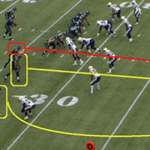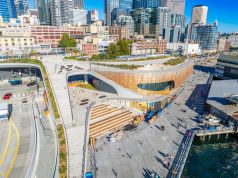Join WTIA in Achieving Civic Goals
 Washington’s high technology trade association, the WTIA, held its own version of an NFL pre-season “OTA” in May and like the Organized Team Activity in football, it was a “full contact,” or more accurately, a FullConTech team-oriented event.
Washington’s high technology trade association, the WTIA, held its own version of an NFL pre-season “OTA” in May and like the Organized Team Activity in football, it was a “full contact,” or more accurately, a FullConTech team-oriented event.
A highlight of the 2017 FullConTech “training camp” was a Civic Playbook packed goal-line to end-zone with nearly 140 ground-gaining solutions covering the civic challenges facing our community and the steps we can take to meet them head on.
Some of the plays focused on new kinds of apps and databases; others involved organizing community activities; still more pointed to mentoring and “sister community” programs. But across all five discussion topics — Education, Transportation, Livability, Health and Economic Development – there was one recurring theme — the human connection.
The Playbook “ground rules” were as follows:
- “Plays” that can be completed within 6-12 months; WTIA will help facilitate volunteer teams that want to pursue these (41 ideas.
- Projects that can be completed in more than 12 months and may require policy changes (72 ideas).
- Projects currently being managed by existing organizations (25 ideas).
All are invited to get in the game and help score these worthy goals. You can sign up to volunteer through WTIA or support an organization already working on a solution you believe in. If you know of an existing program already implementing one or more of the plays, the WTIA is eager to know about it and will cite the organization.
Our coverage spotlights those “field goals” that can be achieved in 6-12 months.
ECONOMICS & GROWTH BASED GOALS
1.1 Bring together tech companies and communities of color in community conversations (e.g., “speed dating” in schools) (Examples: Hack Nation, Tech Month Chicago, Dev Colour)
1.2 Create a tech company day of giving (Company examples: Deloitte’s “Impact Day,” Citi Group’s “Annual Global Community Day,” Google’s Google Serve; also United Way Day of Caring)
1.3 Create a mentorship program targeted to serve one group (women, blacks, black women, etc) (see Our Best initiative)
- Have one company show the way with one community as a role model (TEALS as an analog). Cisco’s citizen teachers, Amazon’s Black Employee Network.
- Get tech employees of race, gender, and ethnic groups to go back to their communities of origin and evangelize. (see: Out in Tech, Microsoft has GLEAM, Amazon has glamazon and Black Employee Network; also Northwest Technology Equity Initiative (NWTEI) is interested in creating an “evangelist/ambassador” program)
- Train non-diverse groups (i.e. white men) to inspire, train, motivate communities
1.4 Organize field trips to tech companies. Examples:
- Google grants to organize field trips to STEM related museums in Silicon Valley
- Puget Sound CS Fair
- Student Field Trip to Microsoft under the TEALS program
- Amazon’s free summer STEM camp to give students access to Amazon’s urban Seattle headquarters and Kent, WA robotics fulfillment center
1.5 Organize field trips for tech workers to visit communities that are left behind. Examples:
- Amazon’s Technology Open House in Seattle to help educate young men and women about career opportunities in technology
- Amazon, Google and the University of Washington — Tech Out!-a day for girls in grades 7-12 to explore technology, engineering and learn from women in the industry during workshops and hands-on activities
1.6 Document life stories of people of color who “made it” so that the storytelling scales and robust data set is formed
1.7 Create a way for small companies to engage employees into giving back initiatives (e.g., Amazon’s Local Love)
1.8 Increase awareness of what companies are doing through their community relations teams
1.9 Develop pro bono consulting practices that
- Elevate social goodness among employees
- Characterize skills/experience
- Provide project management expertise on non-profit projects
Check out Microsoft’s Hack for Good.
1.10 Outsource the Gates Foundation’s employee volunteer program (replicate it at other orgs).
1.11 Outsource the Amazon career choice program (replicate it at other orgs).
1.12 Bring volunteer/engagement opportunities to places where employees spend time outside work
1.13 Put suggestion boxes at companies to welcome ideas
1.14 Create a Mentors-for-Mentors program
1.15 Put volunteer sign-ups at the site of the problem
1.16 Create an app for newcomers to provide shared sense of history for Seattle area (e.g., collaboration with HistoryLink.org)
1.17 Create a program that loans executives to community organizations. Example: TEALS, Google, Per Scholas
1.18 Have organizations publicize and incentivize public/civic service. The Governor’s office sends out monthly announcements on open positions on state boards & commissions. This could be more widely distributed.
1.19 Create a landscape report to map existing resources for workforce development and youth in order to identify gaps and match companies with service and funding opportunities to fill those gaps
EDUCATION-BASED IDEAS
2.1 Create tracking apps for resources, alternatives and career projections
2.2 Collect job requirement information to synthesize and use to help equitably track or provide pathways for students
2.3 Create a service to address the “counselor” function within schools for areas like:
- Identifying career path(s)
- Guides on how to follow path and meet requirements
2.4 Give feedback on job requirements to companies – Are degrees required? Should they be? What equivalent volunteer/internship experience would suffice in lieu of school?
2.5 Create an app to provide early advising and tech (dashboard) for on-track milestones and major requirements
2.6 Provide early advising and text reminders on college graduation requirements and help students stay on-track with milestones and a dashboard
2.7 Create an app for automatic pre-selected college-ready courses in registration tools
2.8 Create a program for training public/private industry mentors to work with students in multi-year relationships; cover gather and making transparent data on student progress, mentoring progress and outcomes
HEALTH-BASED GOALS
3.1 Expand “quality food delivery” services to at-risk areas (See Manna)
3.2 Create a healthy cooking and eating training program (Healthy eating for employees through apps like Zesty)
3.3 Meet with target populations to understand what eating and healthy living options work for them (WA DOH partnerships) LiveWell Colorado’s HEAL Cities & Towns Campaign)
3.4 After school program for teaching kids to cook and building sustainable patterns
- Get credits
- Get food
- Stay on to teach others in a new location
3.5 Create safe, convenient places for kids to exercise
3.6 Provide programs at community centers, like speakers who talk about what they eat and how they exercise
3.7 Create a targeted billboard and Snapchat campaign (or social media campaign) – represent all identities and expressions; culturally relevant (“Your baby is beautiful. Take care of it.) (Massachussets PSA billboard program)
LIVABILITY-BASED GOALS
4.1 Organize coffee chats across neighborhoods
4.2 Design a tool to help build connections across neighborhoods – sister neighborhood program
4.3 Create a toolkit for neighborhood engagement or promote the version created by the City Dept. of Neighborhoods
4.4 Create online/physical poetry posts – taking current pulse of neighborhood, sharing inspiration. See Poetry On Buses project.
TRANSPORTATION-BASED GOALS
5.1 Crowdsourcing to create highway app to augment direction apps like Waze. A volunteer team could launch an online competition or a hackathon. Look at Hack the Commute as a model.
5.2 Create a Carpool app (See Uber and Lyft services)
- Online reservations with people in your neighborhood
- See connections to your community via Facebook, Twitter and other social media to vet people your will carpool with
A volunteer team could launch an online competition or a hackathon.
5.3 Waze for sidewalks to improve pedestrian experience. (See Taskar Center for Accessible Technology, Access Map, Open Sidewalks)
5.4 Data collection on school time spent on buses for disadvantaged population and feed to creating new bus routes or transportation solutions. (NOTE: If the information is volunteered rather than required, a volunteer team could pilot this.)
Michael Schutzler, the president and CEO of the WTIA, explained how the concept of a Civic Engagement Playbook originated:
“We’ve been hearing from techies that they want to collaborate to make our region a great place to live for everyone. We made “Civic Collaboration” the theme of WTIA’s FullConTech this spring to do just that. This Playbook isn’t just a record of the ideas generated at the conference—it’s our guide on what to do next.”
View the WTIA FullConTech Playbook in full online. [24×7]




















